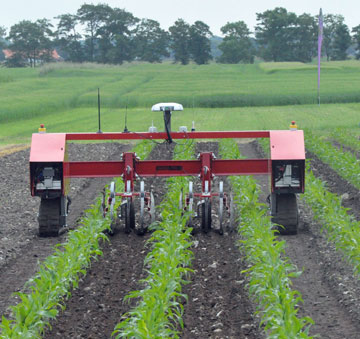
Weeding Robot Ready for Agriculture
Now, the first example of a commercial weeding robot has seen the light of day. The field robot, the result of cooperation between companies and researchers, points towards a more environmentally friendly agriculture.
Most gardeners know it: Weed trickles out and nestle between plants so that the hoe must take care of it. So it is with farmers that have to take more energy-intensive methods in to use. When they fight the weed for instance in the corn field, it typically happens with a hoe fastened to a tractor.
But now a smarter and more environmentally friendly solution is ready. Researchers from the Faculty of Engineering, jointly with the companies Kongskilde Industries A/S and Conpleks Innovation developed a concept model on a weeding robot, called Vibro Crop Robotti. It is equipped with control, tractive force and tools for weed control in a single vehicle.
Paves the way for commercial breakthrough
The new concept model contributes in bringing field robots closer to a commercial breakthrough, estimates one of the researchers behind the project:
- My guess is that we, with Vibro Crop Robotti, are closer to a more widespread use of field robots. Most farmers are happy to use new technology if they can see a profit from it and Vibro Crop Robotti is a good example of a productive arable tool that agriculture can use today to streamline weed clearing, says Kjeld Jensen, PhD student at the Maersk Mc-Kinney Moller Institute.
Example of the future’s agricultural machine
Also companies see great potential in the field robot that works with 5 – 10 km/h and the current model up to 2, 5 hours on a full charge. It opens up a range of new opportunities, says Ole Green, Head of Strategic Development at Kongkilde Industries A/S.
- With the robot we can set the speed of the tool for which it makes sense in the field. We are no longer stressed by having to work at the speed at which a driver is running. Simultaneously, we can let the robot run at the most convenient times – for example, at night, says Ole Green.
Value for agriculture, industry and researchers
Both companies and researchers appreciate the cooperation that begun under the auspices of the Innovation Network RoboCluster.
For us, cooperation has been crucial, and it has aided in making the distance between thought and action shorter. Being close to the latest knowledge gives us and our development some experience at an early stage in these processes, says Tom Simonsen, CEO at Conpleks Innovation.
Knowledge is moved not only from the university to companies. Also in the opposite direction there are good results to reap.
Enterprise collaboration is important for us as the work of field robots and intelligent tools cut across many disciplines – such as agricultural science, design, mechanical design, electronics and robotics. By working closely with the industry, we can draw on many years of experience in machine production, adds Kjeld Jensen.
For more information
PhD student Kjeld Jensen at kjen@mmmi.sdu.dk / phone: 2778 1926